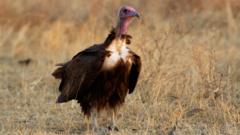Is the US Prepared for Its First Human Case of Flesh-Eating Screwworm?

Published: 2025-08-25 07:35:05 | Category: News
This article examines the alarming emergence of the New World screwworm, a deadly flesh-eating parasite, detected in a human for the first time in the US. The case was identified in an individual returning from El Salvador, prompting investigations by health authorities. While the immediate risk to public health is deemed low, the historical impact of this parasite on livestock raises significant concerns for agriculture and public awareness.
Last updated: 30 October 2023 (BST)
Key Takeaways
- The New World screwworm has infected a human for the first time in the US.
- This parasite primarily affects livestock and wildlife, with significant economic implications.
- The risk to public health is currently considered low, according to health officials.
- Effective treatment involves meticulous removal of larvae and potential complications.
- Historical methods of control may be reapplied to prevent future outbreaks.
Understanding the New World Screwworm
The New World screwworm (Cochliomyia hominivorax) is a parasitic fly whose larvae are notorious for infesting warm-blooded animals. They lay eggs in open wounds, and once hatched, the larvae burrow into the flesh, causing severe tissue damage. This parasite is primarily associated with livestock, particularly cattle, and has a notorious history of devastating outbreaks.
Historical Context
Once widespread in the US, the New World screwworm was eradicated through a successful sterilisation programme in the 1960s. The program involved releasing sterile male flies into the wild to mate with females, effectively reducing the population. However, recent climate changes and migration patterns may be contributing to a resurgence of the parasite in new regions.
The Recent Case and Immediate Response
The detection of the New World screwworm in a human is a significant development, albeit a rare one. The infected individual had recently travelled to El Salvador, a country where this parasite is endemic. Following this case, health authorities, including the Maryland Department of Health and the U.S. Centers for Disease Control and Prevention (CDC), have initiated investigations to monitor and contain potential risks.
Public Health Risks
According to Andrew G. Nixon from the Department of Health and Human Services, the overall risk to the US public is very low. However, the situation highlights the importance of vigilance, particularly in regions where the parasite may spread. The primary concern remains for livestock, with potential economic repercussions for farmers, particularly in states like Texas.
Economic Implications for Agriculture
The economic impact of a screwworm outbreak can be staggering. The US Department of Agriculture estimates that an outbreak in Texas alone could cost the state around £1.3 billion ($1.8 billion). This financial burden emphasizes the need for proactive measures to prevent the spread of the parasite.
Preventative Measures and Future Strategies
To combat the potential spread of the New World screwworm, Agriculture Secretary Brooke Rollins announced plans to establish a sterile fly facility in Texas. This initiative will produce sterilised male flies to reduce the wild population, following historical methods that proved successful in the past. These measures are crucial as climate change potentially facilitates the northward movement of screwworm cases from Central America.
Treatment Challenges
Treating screwworm infestations is a complex process. Once larvae burrow into the flesh, removal is painstaking and requires careful disinfection of the wound. If untreated, infections can lead to severe complications or even death, underscoring the importance of early detection and intervention.
Symptoms of Infection
Individuals infected with screwworms may experience various symptoms, including:
- Severe pain in the affected area
- Visible larvae or discharge from wounds
- Swelling and inflammation around the site of infestation
Prompt medical attention is essential for successful treatment and recovery.
Conclusion: Vigilance is Key
The emergence of the New World screwworm in a human case serves as a stark reminder of the interconnectedness of animal and human health. While the current risk is low, the potential for economic disruption in agriculture necessitates proactive measures to mitigate future outbreaks. As climate conditions evolve, ongoing monitoring and effective response strategies will be essential to safeguard public and agricultural health.
As we move forward, the question remains: how can we ensure that such parasites do not pose a significant threat to public health and agriculture in the future? #Screwworm #PublicHealth #Agriculture
FAQs
What is the New World screwworm?
The New World screwworm is a parasitic fly whose larvae infest warm-blooded animals, causing severe tissue damage and can lead to fatal infections if untreated.
How does the screwworm affect humans?
While rare, the New World screwworm can infect humans, particularly if they have open wounds. The larvae burrow into the flesh, necessitating urgent medical treatment.
What are the symptoms of screwworm infestation?
Symptoms include severe pain, visible larvae in wounds, swelling, and inflammation. Early detection is crucial for effective treatment.
What measures are being taken to prevent screwworm outbreaks?
Preventative measures include establishing sterile fly facilities to produce sterilised males, along with ongoing monitoring of potential cases in livestock and humans.
What are the economic implications of a screwworm outbreak?
An outbreak can have severe economic consequences, particularly for livestock farmers. Estimates suggest losses could reach billions in affected states, such as Texas.



